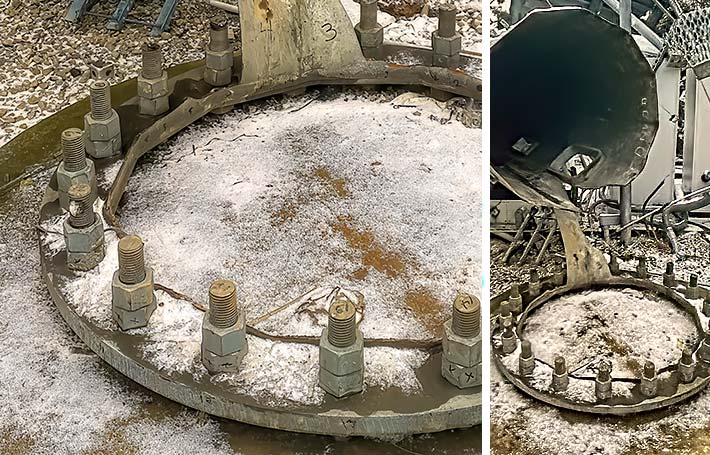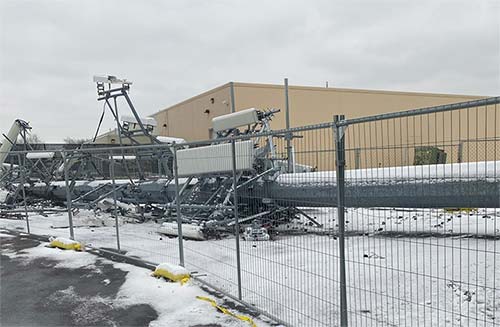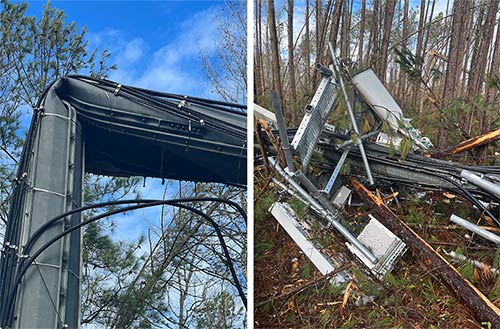
THE WEAK LINK in a flawed design that could have caused this 114-foot monopole to collapse last month could have been an overstressed base plate. A design engineer’s error was known by American Tower when the company filed a lawsuit in 2004 against manufacturer Fred A. Nudd. It is unknown if American Tower retrofitted this Nudd tower that fell behind a supermarket in Depew, NY.
UPDATE: February 3, 2023 – An American Tower representative has informed Wireless Estimator that the Fred A. Nudd monopole that collapsed in Depew, NY, during a winter blizzard was not subject to the litigation with Nudd and would have been out of scope for any remedial work required to ensure that it complied with design standards.
This site was part of a larger program that monitored structural conditions (including baseplate welding) at certain tower sites. It was reviewed at regular intervals and assessed as recently as March 2022, when it did not show any signs of overstress, American Tower said in a statement.
The company said that the monopole was subject to several structural analyses over the years, including when it was modified to accommodate Verizon as a tenant.
A Nudd spokesperson had previously informed Wireless Estimator that they believed the Depew monopole had been fabricated using the same faulty engineering regarding baseplate design for all of their monopoles fabricated in the late 90s and early 2000.
They said today that all of their records were in storage and not readily available.
The Christmas weekend blizzard that crippled western New York, causing dozens of fatalities, cut off cell tower service to many residents in the Village of Depew when an American Tower-managed multi-carrier 114-foot monopole collapsed behind a Wegman’s supermarket.
The event was largely unknown in industry circles since it was not reported in local or other media.
Although the structure has been removed, a question remains about whether the tower was toppled by Mother Nature or a deficient design that didn’t meet the engineering standards that American Tower Corporation (ATC) was aware of not being compliant with an EIA design standard.
An onslaught of wind gusts up to 69 mph and blowing snow pummeled the area and could have caused the structure to collapse since it was erected in 1999 when the design code at that time was EIA/TIA 222-F for Erie County, which required for a 70 mph wind design and allowed for two methods for the analysis of ice.
Design flaws found in dozens of monopoles

FIVE TENANTS were co-located on this American Tower monopole when it fell last month. It is unknown if the structure was replaced or retrofitted after ATC paid for a third-party analysis around 2002 that discovered that the shaft and base plate were overstressed.
However, the Fred A. Nudd-manufactured monopole in Depew was one of the dozens of monopoles that had a checkered history of design flaws that were uncovered when the major towercos analyzed the structures for future loading requirements.
Their discovery led to multiple lawsuits alleging that Nudd’s consulting engineer did not incorporate a gust response factor and failed to incorporate P-delta effects that increase lateral flexibility for members under compression.
ATC acquired tower developer Unisite who had purchased numerous monopoles from Nudd for various leased and owned sites where they were erected.
In its 2004 lawsuit, ATC said that all of the monopoles were designed to support five carriers.
ATC said it had analyzed the monopoles and found that the base plates were overstressed by at least 180% and failed to meet EIA standards.
The over-stress was occurring at only a two-to-three-tenant loading, according to ATC.
In their complaint, ATC said that in addition to the base plate overstress, as a result of the design flaw, the monopole shafts and the foundations had experienced damage and stress as well.
Engineer finds that the poles were 32% under-designed
ATC hired a third-party engineer to review the Nudd design and found that they may be as much as 32% under-designed.

MONOPOLES TYPICALLY COLLAPSE like a bent straw during hurricanes or severe storms, such as this one did in Griffin, GA, when it lost a battle earlier this month with a tornado. For some site approvals, the manufacturer has to provide a theoretical break point design to ensure that it falls within a specified boundary.
Nudd, according to ATC, committed to the towerco that it would retrofit the monopoles to be compliant by providing gussets and other reinforcement design requirements.
In its site portfolio, ATC said it had identified that it had 41 Nudd poles.
After 21 monopoles were retrofitted, ATC said that Nudd was “consistently late in preparing the redesigns and engineered drawings necessary for the retrofitting work to be performed on the monopoles.”
ATC said in its filing that due to Nudd’s delays, they had to pay for contractors and materials to retrofit the remaining monopoles.
They also said that after inspecting Nudd’s retrofitting work, the towers were still not able to support five tenants.
ATC wanted over $5 million but settled for an undisclosed amount
Their lawsuit said they would need to replace all 41 monopoles and foundations at the cost of $125,000 each. The $5 million-plus request did not include attorneys, engineering, and management fees.
Nudd, in a third-party complaint against its consulting engineer, Underhill Consulting Engineer P.C., stated that in the event ATC should recover any judgment against Nudd, they would be entitled to a judgment against Underhill.
On August 25, 2005, the parties, ATC, Nudd, Underhill and Nudd’s insurer, Granite State Insurance, reached an agreement where an undisclosed payment amount would be made to ATC, and dismissal was filed and approved by the court.
Depew’s monopole didn’t appear to have been retrofitted, possibly causing the failure
The Depew monopole, when installed, was 90 feet in height, a Nudd representative informed Wireless Estimator on Wednesday.
However, after the settlement, to add another tenant, reportedly Verizon, the AT&T-owned structure was raised 24 feet, according to the FCC registration that lists the height at 114 feet.
The Nudd spokesperson said they neither provided a design nor fabricated sections to raise the structure’s height.
According to a photograph above, obtained by Wireless Estimator, the base did not have gussets to retrofit it if it was 180% overstressed and the monopole’s failure was at that location.
In addition, it didn’t appear to have shaft stiffeners or any other reinforcement system.
The collapsed monopole had five tenants on it even though ATC said in their lawsuit that the monopoles could only accommodate two or three tenants.
American Tower did not respond to a request for additional information.
















